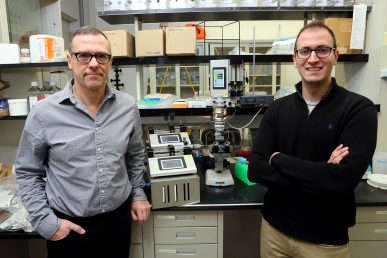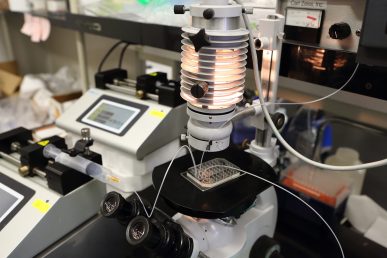While many cells in our bodies can accumulate oncogenic mutations, the majority of these events do not lead to tumor formation as these abnormal cells are eliminated by defense mechanisms. Instead, tumors arise when a mutation happens in a particular cell type that is uniquely sensitive to it. Identifying such cancer cells of origin is essential to properly target cancer.
For example, mutations in the retinoblastoma (RB) tumor suppressor gene, which normally blocks abnormal cell growth and division, gives rise to retinoblastoma, a type of eye tumor. Retinoblastoma arises in specialized retinal cells called cone cells, which collect light. Why this kind of cancer always starts in cone cells is unknown. But if scientists can get a clearer, more accurate view of the downstream effects of RB mutations in cone cells versus other cells in the retina, they may identify unique therapeutic targets that can prevent or treat retinoblastoma with laser-like precision.

But studying the effects of gene mutations in specific cell types is easier said than done. It is nearly impossible to collect pure samples made up of just one cell type. Instead, scientists often have to use a bulk sample prepared from an entire tissue.
“This only gives a sort of average picture of gene expression in individual cells since it pools thousands of cells, some of which may be unwanted no matter how much the sample is purified. The results of examining the effects of RB mutations using these kinds of samples don’t accurately represent how an RB mutation affects gene expression in a particular cell type,” said Maxim Frolov, professor of biochemistry and molecular genetics in the University of Illinois at Chicago College of Medicine.
A revolutionary new technology called single-cell RNA sequencing lets researchers study gene expression in individual cells, eliminating the problem of contaminated cell samples and averaging. Frolov’s laboratory adapted a technology called Drop-seq, which allows researchers to isolate and genetically sequence single cells. Drop-seq can sequence thousands of individual cells at the same time.
Frolov and his graduate student, Majd Ariss, assembled a Drop-seq instrument to isolate cells of the eye in developing fruit flies, which the lab uses as a model system. Then they were able to study gene expression changes caused by mutations in the RB gene in thousands of different cells in the eye compared with gene expression in cells with normal copies of the RB gene. Their results are published in Nature Communications.

“Since this is the first time single-cell RNA sequencing has been performed in cells of the fruit fly eye, we had to create a comprehensive map or cell atlas, accurately describing gene expression in each cell type in the normal eye. We then relied on this atlas to determine how an RB mutation affects gene expression of each cell type in the eye,” Frolov explained.
Their analysis of eye cells with an RB mutation revealed a distinctive but small population of cells where the mutation altered gene expression and changed cell metabolism. The metabolic change sensitized the cells to apoptosis or self-induced cell death. The propensity of cells with mutations in the RB gene to undergo apoptosis is a well-known phenomenon and is eventually overcome through additional mutations during the development of cancer, which is characterized by out-of-control cell growth and division — the opposite of apoptosis.
“The metabolic changes we observed in RB mutant cells make them vulnerable in ways that might be exploited with therapeutic approaches before additional mutations hit the same cell, making them resistant to cell death,” Frolov said. “Since these effects were limited to such a small group of cells, they were previously missed when whole RB mutant eye tissue was analyzed.”
The Drop-seq platform took Ariss more than three months to build. He painstakingly followed instructions contained in a 40-page manual to generate his first single-cell RNA sequencing dataset.
“Single cell sequencing is a truly revolutionary technology that promises to shed new light on the origin of cancer and why certain cancers originate in certain cell types and not others. Only now can we begin to investigate why and how. For the past year and a half, we performed over a hundred experiments and generated transcriptomes of more than a hundred thousand cells from fruit fly organs, mouse tumors, and human cell lines,” Frolov said.
Source – University of Illinois at Chicago
免责声明:部分图片来源于网络,如有侵权请联系删除!

